Health Assessment and Remaining Useful Life Prediction of Wind Turbine High-Speed Shaft Bearings
Abstract
:1. Introduction
2. Theoretical Methodology
2.1. Feature Evaluation Indicators
2.1.1. Monotonicity
2.1.2. Correlation
2.1.3. Robustness
2.2. Minimum Quantization Error Based on SOM
2.2.1. SOM
2.2.2. Minimum Quantization Error
2.3. Degradation Model and Life Prediction
2.3.1. Degradation Modeling
2.3.2. Stochastic Parameter Update of the Degradation Model Based on the Bayesian Method
2.3.3. RUL Prediction
2.3.4. Parameter Estimation Based on EM Algorithm
- (1)
- Calculatewhere represents the latest value of the ith iteration.
- (2)
- Calculate .
3. Plan Steps
3.1. Construct Comprehensive Evaluation Function
3.2. Construct HI Curve
- Collect acceleration vibration signals of wind turbine HSSB;
- Extract degradation features of the vibration signal in the time, frequency, and time–frequency domain;
- Construct a comprehensive evaluation function considering monotonicity, correlation, and robustness and use the comprehensive evaluation function to select degradation features with excellent performance;
- Use SOM to fuse the selected degradation features;
- Calculate the minimum quantization error and construct the HI curve.
3.3. Use Exponential Degradation Model to Predict the RUL of HSSB
- Select the exponential degradation model according to the constructed health index curve;
- Initialize the degradation model parameters;
- Utilize the method combining Bayesian update and expectation–maximization algorithm to update and estimate the exponential degradation model parameters;
- Predict the RUL of high-speed shaft bearings.
4. Data Analysis
4.1. Data Sets
4.2. Extract Degradation Features
4.2.1. Time Domain Features
4.2.2. Frequency-Domain Features
4.2.3. Time–Frequency Domain Features
4.3. Select Degradation Features
4.4. Construct HI Curve
4.5. Using an Exponential Degradation Model to Predict the RUL of HSSB
4.6. Evaluation Index
5. Conclusions
- For the extracted high-dimensional degradation features, the comprehensive evaluation function can be used to eliminate features that do not reflect the degradation process of the wind turbine HSSB and that cannot reflect the degradation process effectively.
- It is difficult to reflect the degradation trend of wind turbine HSSB with a single time-frequency degradation feature. The HI curve generated by fusing the selected degradation features with the SOM algorithm can more accurately reflect the health status of HSSB.
- For the wind turbine HSSB, which lacks similar life cycle degradation data, the exponential degradation model based on the Bayesian update and expectation–maximization algorithm has degradation model parameters that will continue to update and continuous improvement of RUL prediction accuracy with the continuous accumulation of historical operation data.
Author Contributions
Funding
Institutional Review Board Statement
Informed Consent Statement
Data Availability Statement
Conflicts of Interest
References
- Nie, M.Y.; Wang, L. Review of condition monitoring and fault diagnosis technologies for wind turbine gearbox. Procedia CIRP 2013, 11, 287–290. [Google Scholar] [CrossRef] [Green Version]
- Martinez-Luengo, M.; Kolios, A.; Wang, L. Structural health monitoring of offshore wind turbines: A review through the Statistical Pattern Recognition Paradigm. Renew. Sustain. Energy Rev. 2016, 64, 91–105. [Google Scholar] [CrossRef] [Green Version]
- Wiese, B.; Pedersen, N.L.; Nadimi, E.S.; Herp, J. Estimating the Remaining Power Generation of Wind Turbines—An Exploratory Study for Main Bearing Failures. Energies 2020, 13, 3406. [Google Scholar] [CrossRef]
- Dávila, Á.; Puruncajas, B.; Tutivén, C.; Vidal, Y. Wind Turbine Main Bearing Fault Prognosis Based Solely on SCADA Data. Sensors 2021, 21, 1–22. [Google Scholar]
- Lei, Y.G.; Li, N.P.; Guo, L.; Li, N.B.; Yan, T.; Jing, L. Machinery health prognostics: A systematic review from data acquisition to RUL prediction. Mech. Syst. Signal. Process. 2018, 104, 799–834. [Google Scholar] [CrossRef]
- Camci, F.; Medjaher, K.; Zerhouni, N.; Nectoux, P. Feature Evaluation for Effective Bearing Prognostics. Qual. Reliab. Eng. Int. 2013, 29, 477–486. [Google Scholar] [CrossRef] [Green Version]
- Saidi, L.; Ali, J.B.; Bechhoefer, E.; Benbouzid, M. Wind turbine high-speed shaft bearings health prognosis through a spectral Kurtosis-derived indices and SVR. Appl. Acoust. 2017, 120, 1–8. [Google Scholar] [CrossRef]
- Jin, X.H.; Sun, Y.; Que, Z.J.; Wang, Y.; Chow, W.S.T. Anomaly Detection and Fault Prognosis for Bearings. IEEE Trans. Instrum. Meas. 2016, 65, 2046–2054. [Google Scholar] [CrossRef]
- Zhao, S.K.; Jiang, C.; Long, X.Y. A residual life prediction method for mechanical systems based on data driven and Bayesian theory. J. Mech. Eng. 2018, 54, 115–124. [Google Scholar] [CrossRef]
- Yu, J.B. Health Condition Monitoring of Machines Based on Hidden Markov Model and Contribution Analysis. IEEE Trans. Instrum. Meas. 2012, 61, 2200–2211. [Google Scholar] [CrossRef]
- Javed, K.; Gouriveau, R.; Zerhouni, N.; Nectoux, P. Enabling Health Monitoring Approach Based on Vibration Data for Accurate Prognostics. IEEE Trans. Ind. Electron. 2015, 62, 647–656. [Google Scholar] [CrossRef] [Green Version]
- Zhang, B.; Zhang, L.J.; Xu, J.W. Degradation Feature Selection for Remaining Useful Life Prediction of Rolling Element Bearings. Qual. Reliab. Eng. Int. 2016, 32, 547–554. [Google Scholar] [CrossRef]
- Liao, L.X.; Jin, W.J.; Pavel, R. Enhanced Restricted Boltzmann Machine with Prognosability Regularization for Prognostics and Health Assessment. IEEE Trans. Ind. Electron. 2016, 63, 7076–7083. [Google Scholar] [CrossRef]
- Rai, A.; Upadhyay, S.H. Intelligent bearing performance degradation assessment and remaining useful life prediction based on self-organising map and support vector regression. J. Mech. Eng. Sci. 2017, 1–15. [Google Scholar] [CrossRef]
- Kudela, P.; Radzienski, M.; Ostachowicz, W.; Yang, Z.B. Structural Health Monitoring system based on a concept of Lamb wave focusing by the piezoelectric array. Mech. Syst. Signal. Process. 2018, 108, 21–32. [Google Scholar] [CrossRef]
- Shi, J.M.; Li, Y.X.; Wang, G.; Li, X.Z. Health index synthetization and remaining useful life estimation for turbofan engines based on run-to-failure datasets. Eksploat. I Niezawodn. Maint. Reliab. 2016, 18, 621–631. [Google Scholar] [CrossRef]
- Tian, Q.; Wang, H. An Ensemble Learning and RUL Prediction Method Based on Bearings Degradation Indicator Construction. Appl. Sci. 2020, 10, 346. [Google Scholar] [CrossRef] [Green Version]
- Berghout, T.; Benbouzid, M.; Mouss, H. Leveraging Label Information in a Knowledge-Driven Approach for Rolling-Element Bearings Remaining Useful Life Prediction. Energies 2021, 14, 2163. [Google Scholar] [CrossRef]
- Tian, Q.; Wang, H. Predicting Remaining Useful Life of Rolling Bearings Based on Reliable Degradation Indicator and Temporal Convolution Network with the Quantile Regression. Appl. Sci. 2021, 11, 4773. [Google Scholar] [CrossRef]
- Park, J.I.; Bae, S.J. Direct Prediction Methods on Lifetime Distribution of Organic Light-Emitting Diodes from Accelerated Degradation Tests. IEEE Trans. Reliab. 2010, 59, 74–90. [Google Scholar] [CrossRef]
- Li, N.P.; Lei, Y.G.; Lin, J.; Ding, S.X. An Improved Exponential Model for Predicting Remaining Useful Life of Rolling Element Bearings. IEEE Trans. Ind. Electron. 2015, 62, 7762–7773. [Google Scholar] [CrossRef]
- Gebraeel, N.Z.; Lawley, M.A.; Li, R.; Ryan, J.K. Residual-life distributions from component degradation signals: A Bayesian approach. IIE Trans. 2005, 37, 534–557. [Google Scholar] [CrossRef]
- Si, X.S.; Wang, W.B.; Chen, M.Y.; Hu, C.H.; Zhou, D.H. A degradation path-dependent approach for remaining useful life estimation with an exact and closed-form solution. Eur. J. Oper. Res. 2013, 226, 53–66. [Google Scholar] [CrossRef]
- Sun, G.X.; Zhang, Q.H.; Wen, C.L.; Duan, Z.H. A Stochastic Degradation Modeling Based Adaptive Prognostic Approach for Equipment. Chin. J. Electron. 2015, 43, 1119–1126. [Google Scholar]
- Qiao, G.N. Fault Diagnosis and Health Prediction of High-Speed Train Transmission System Based on Multi-Sensor Fusion. Ph.D. Thesis, Ji Lin University, Changchun, China, December 2019. [Google Scholar]
- Kohonen, T.; Kaski, S.; Somervuo, P.; Lagus, K.; Oja, M.; Paatero, V. Self-organizing map. Proc. IEEE 1990, 78, 1464–1480. [Google Scholar] [CrossRef]
- Hong, S.; Zhou, Z.; Zio, E.; Hong, K. Condition assessment for the performance degradation of bearing based on a combinatorial feature extraction method. Digit. Signal Process. 2014, 27, 159–166. [Google Scholar] [CrossRef]
- Qiu, H.; Lee, J.; Lin, J.; Yu, G. Robust performance degradation assessment methods for enhanced rolling element bearing prognostics. Adv. Eng. Inform. 2003, 17, 127–140. [Google Scholar] [CrossRef]
- Si, X.S.; Hu, C.H.; Li, J.; Chen, M.Y. Degradation Data-Driven Remaining Useful Life Estimation Approach under Collaboration between Bayesian Updating and EM Algorithm. Pattern Recognit. Artif. Intell. 2013, 26, 357–365. [Google Scholar]
- ALI, J.B.; SAIDI, L.; Harrath, S.; Bechhoefer, E.; Benbouzid, M. Online automatic diagnosis of wind turbine bearings progressive degradations under real experimental conditions based on unsupervised machine learning. Appl. Acoust. 2018, 32, 167–181. [Google Scholar]
- Ou, L.; Yu, D.J. Rolling Bearing Fault Diagnosis Based on Supervised Laplaian Score and Principal Component Analysis. J. Mech. Eng. 2014, 50, 88–94. [Google Scholar] [CrossRef]
- Yeh, J.R.; Shieh, J.S.; Huang, N.E. Complementary Ensemble Empirical Mode Decomposition: A Novel Noise Enhanced Data Analysis Method. Adv. Adapt. Data Anal. 2010, 2, 135–164. [Google Scholar] [CrossRef]
- Yan, H.; Deng, Y. An Improved Belief Entropy in Evidence Theory. IEEE Access 2020, 99, 57505–57516. [Google Scholar] [CrossRef]
- Zhang, Y.A.; Yan, B.B.; Aasma, M. A novel deep learning framework: Prediction and analysis of financial time series using CEEMD and LSTM. Expert Syst. Appl. 2020, 159, 113609–113629. [Google Scholar] [CrossRef]
- An, G.; Tong, Q.; Zhang, Y.; Liu, R.; Li, W.; Cao, J.; Lin, Y. An Improved Variational Mode Decomposition and Its Application on Fault Feature Extraction of Rolling Element Bearing. Energies 2021, 14, 1079. [Google Scholar] [CrossRef]
- Xu, S.; Hou, Y.; Deng, X.; Ouyang, K.; Zhang, Y.; Zhou, S. Conflict Management for Target Recognition Based on PPT Entropy and Entropy Distance. Energies 2021, 14, 1143. [Google Scholar] [CrossRef]
- Li, H.; Li, F.; Jia, R.; Zhai, F.; Bai, L.; Luo, X. Research on the Fault Feature Extraction of Rolling Bearings Based on SGMD-CS and the AdaBoost Framework. Energies 2021, 14, 1–19. [Google Scholar]
- Tian, G.D.; Zhang, H.H.; Feng, Y.X.; Jia, H.F.; Zhang, C.Y.; Jiang, Z.G.; Li, Z.W.; Li, P.G. Operation patterns analysis of automotive components remanufacturing industry development in China. J. Clean. Prod. 2017, 164, 1363–1375. [Google Scholar] [CrossRef]
- Wang, D.; Tsui, K.L.; Miao, Q. Prognostics and Health Management: A Review of Vibration Based Bearing and Gear Health Indicators. IEEE Access 2018, 6, 665–676. [Google Scholar] [CrossRef]
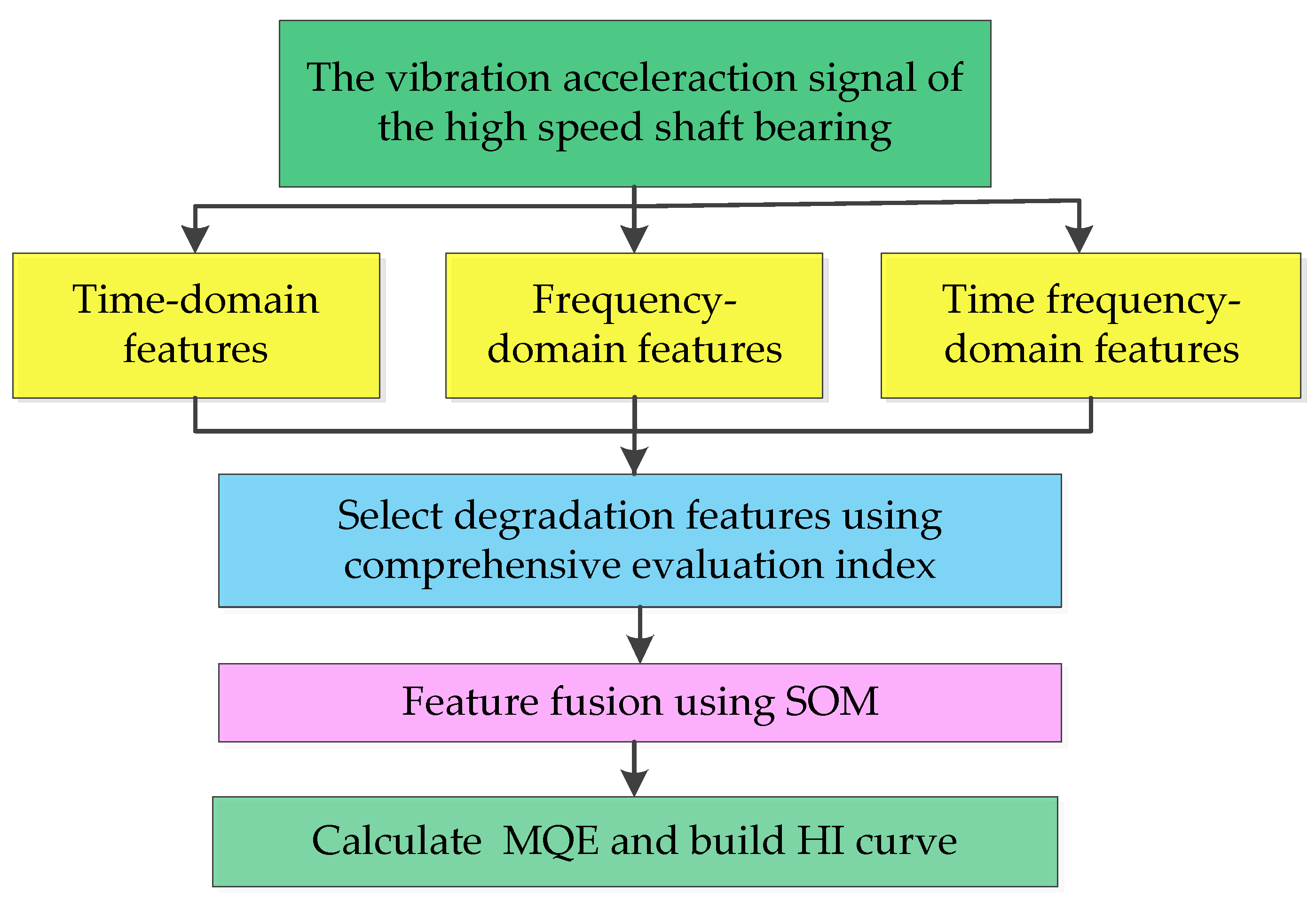
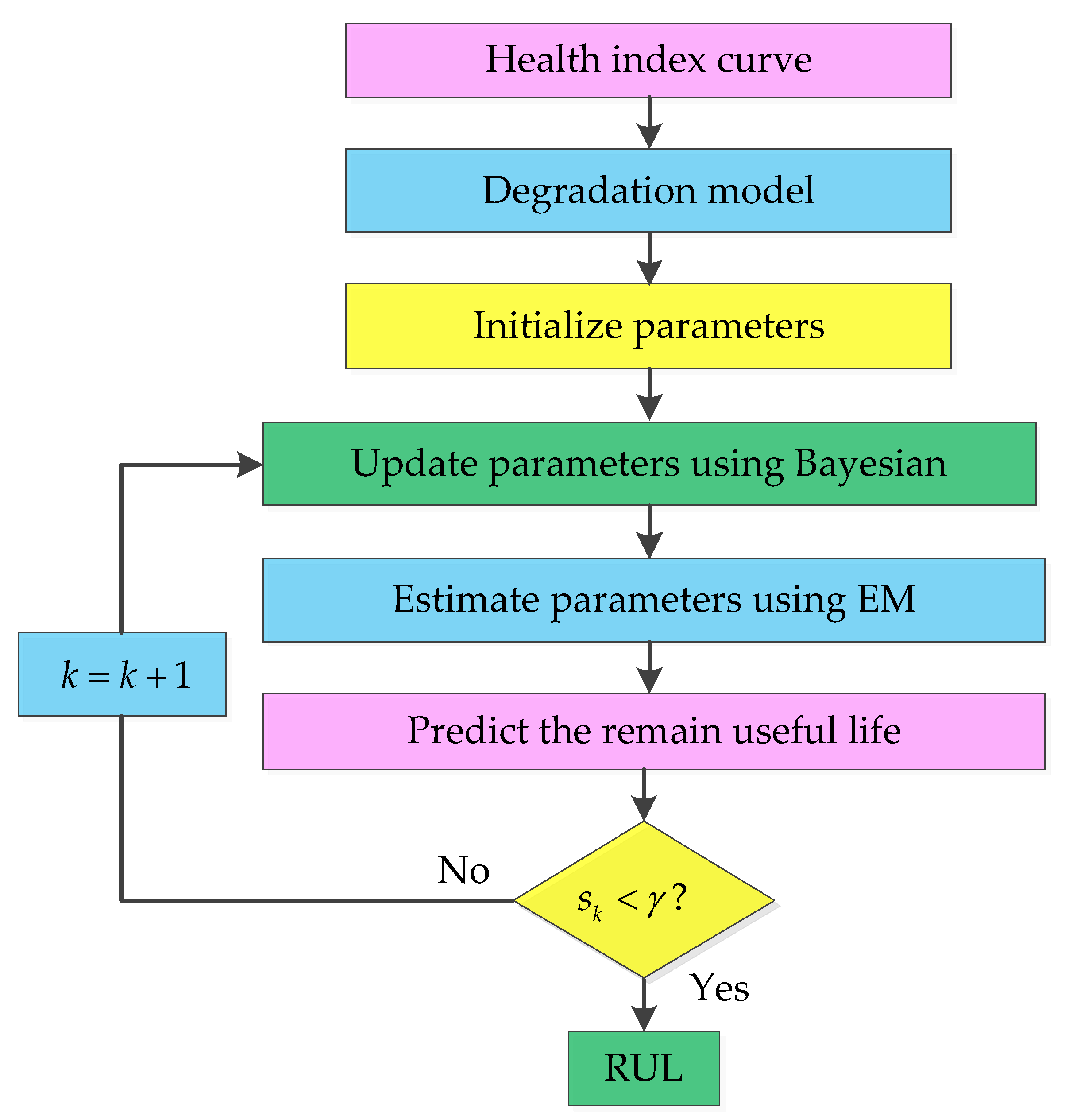
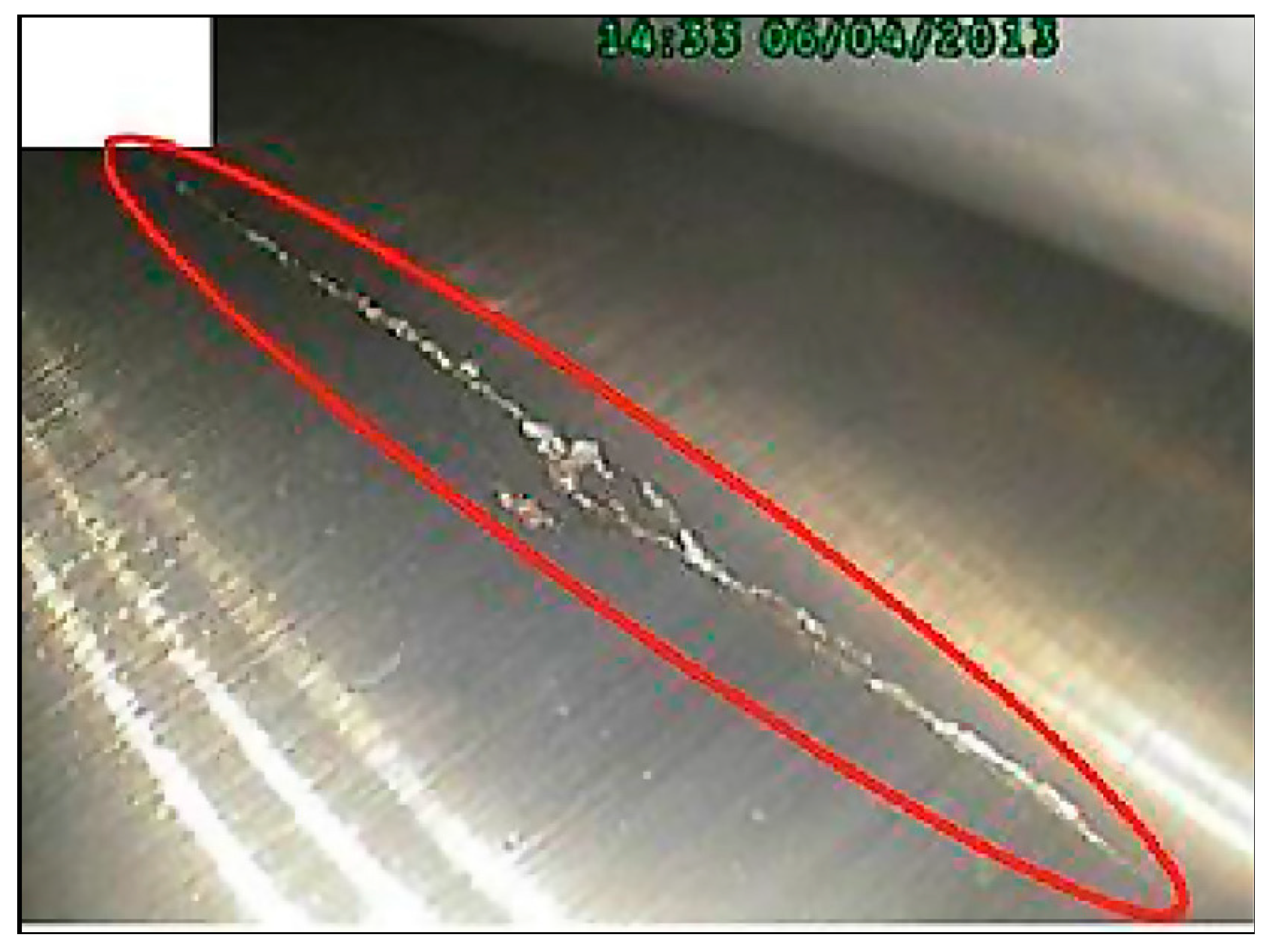
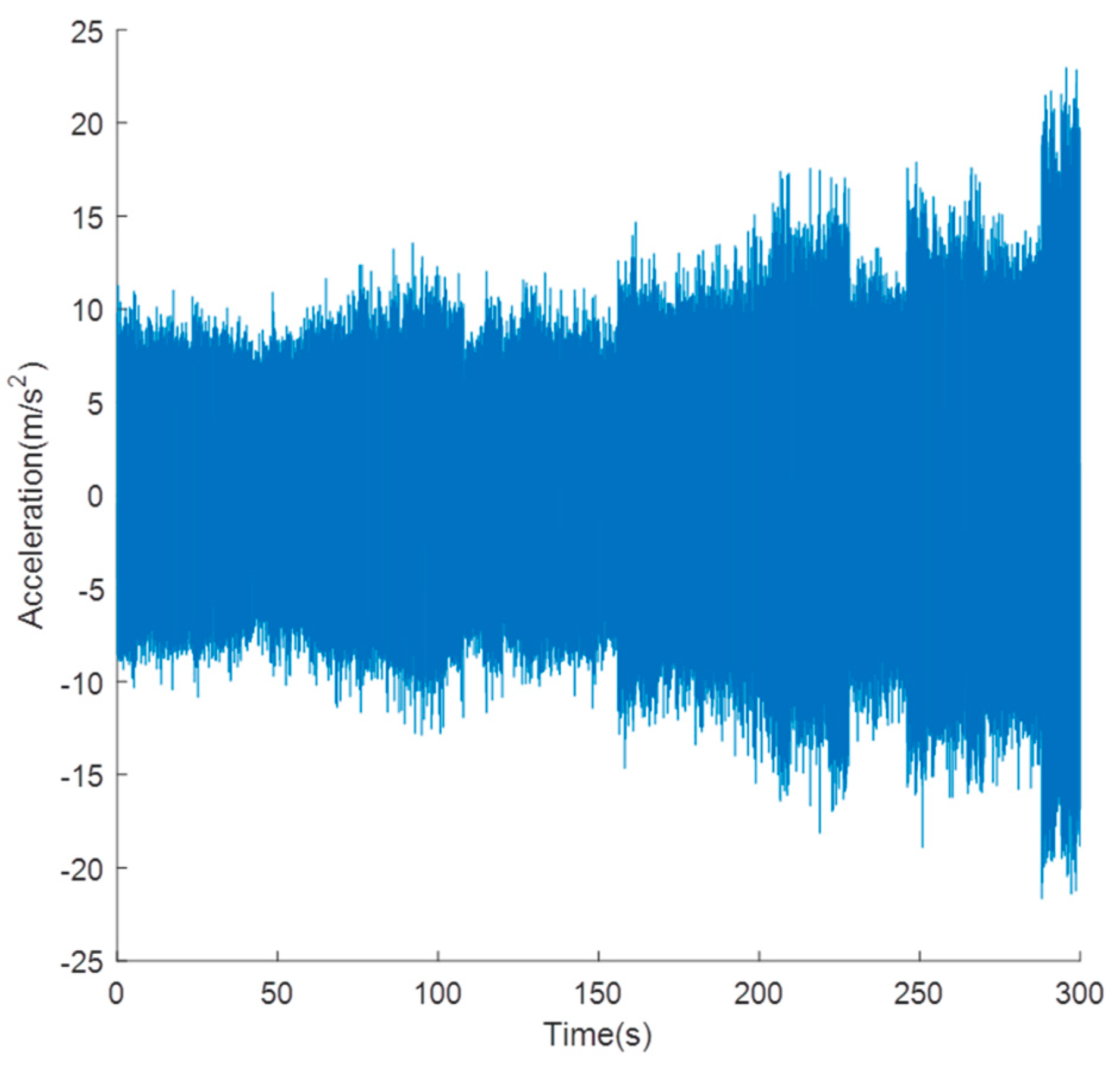
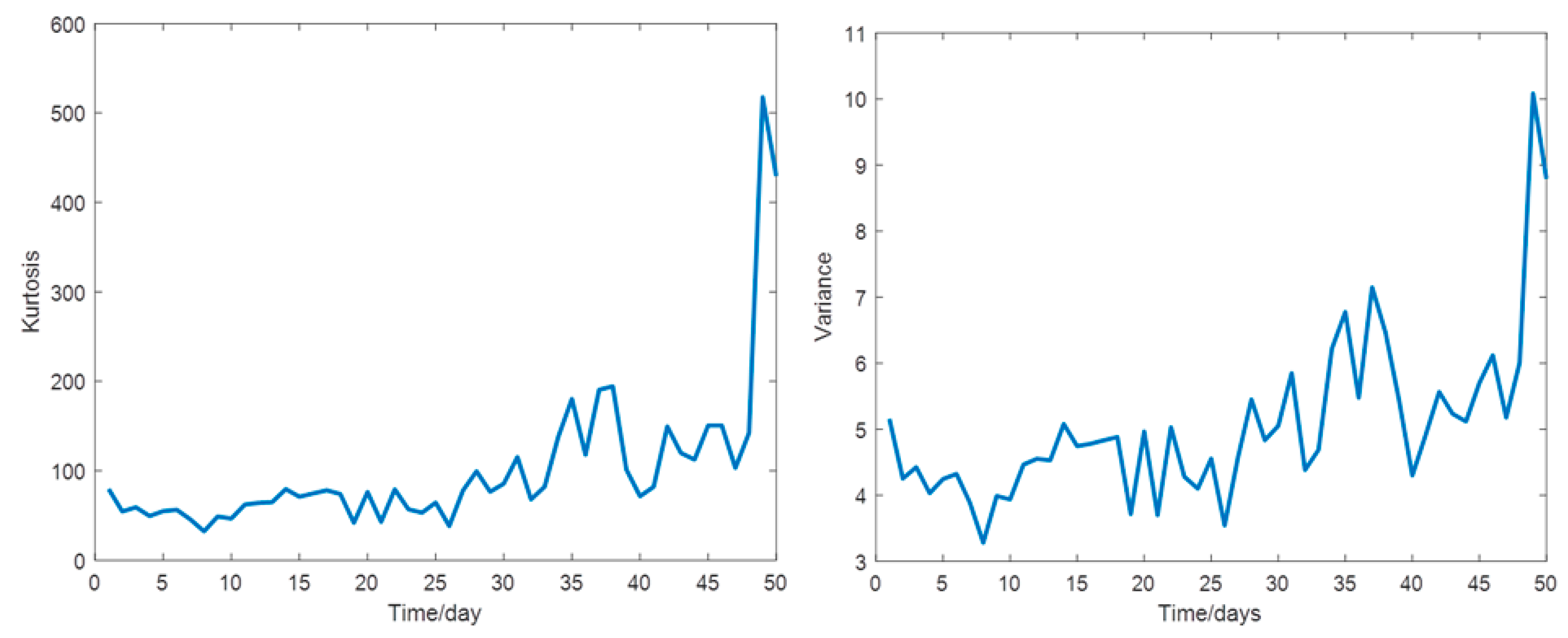
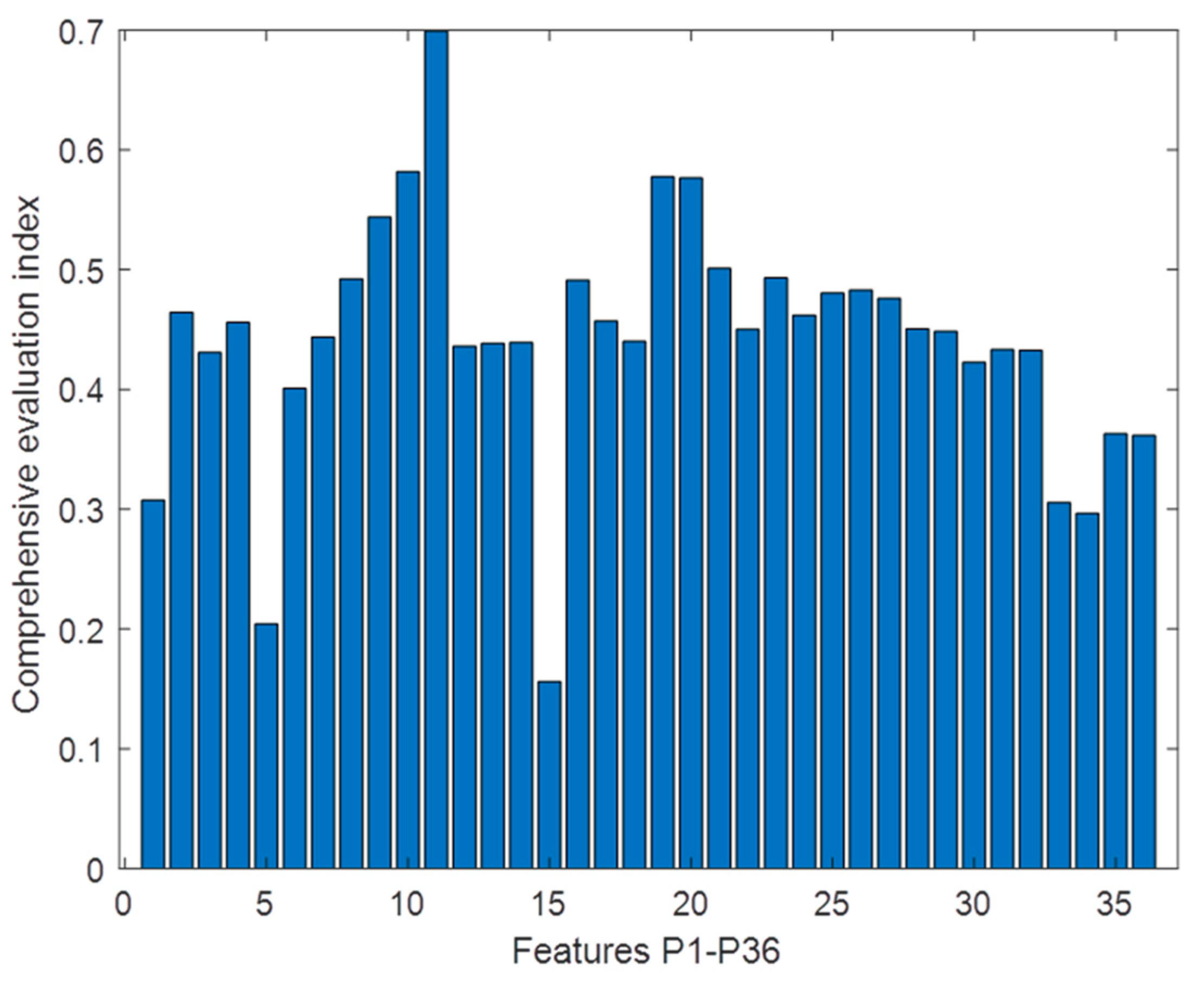


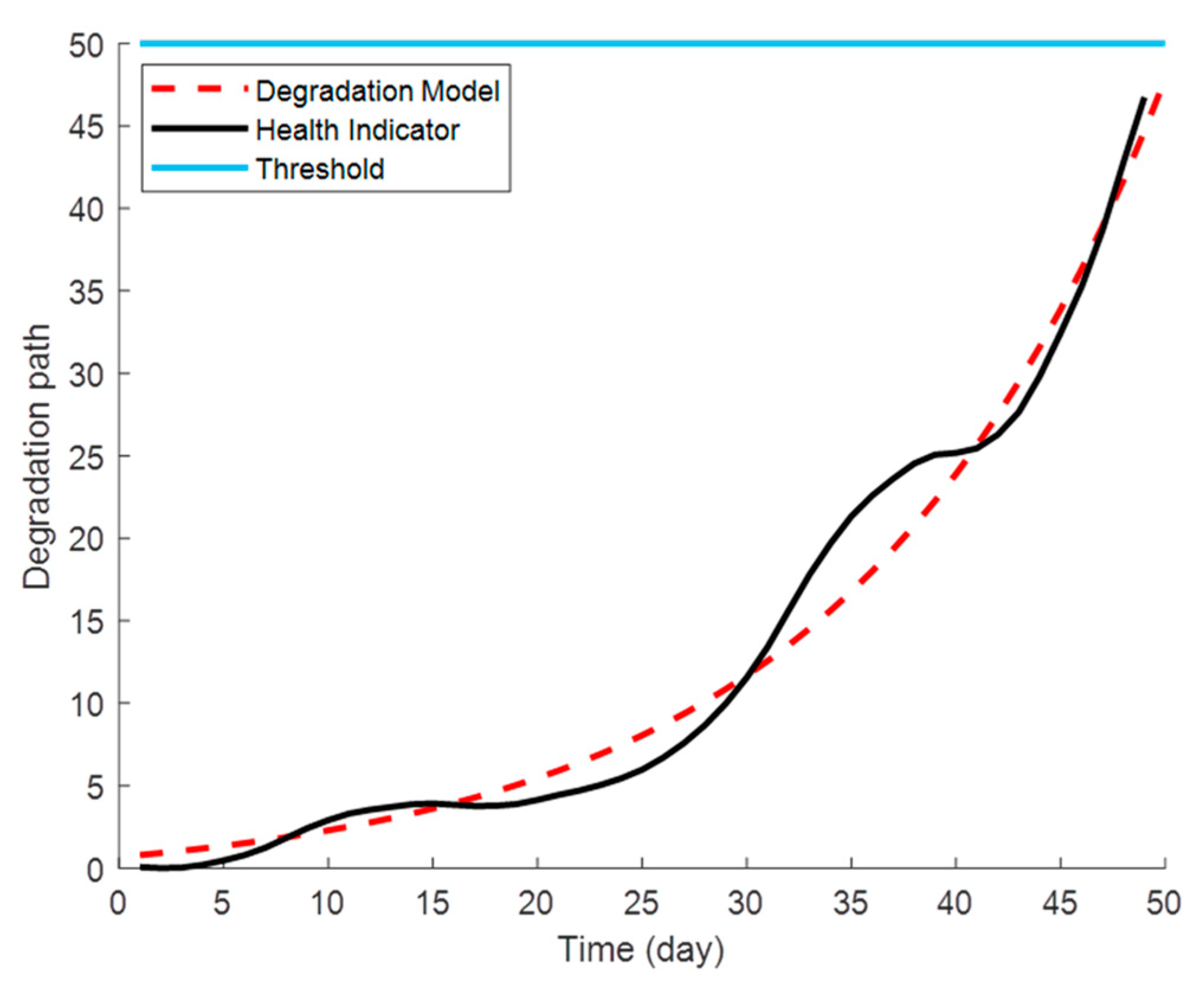
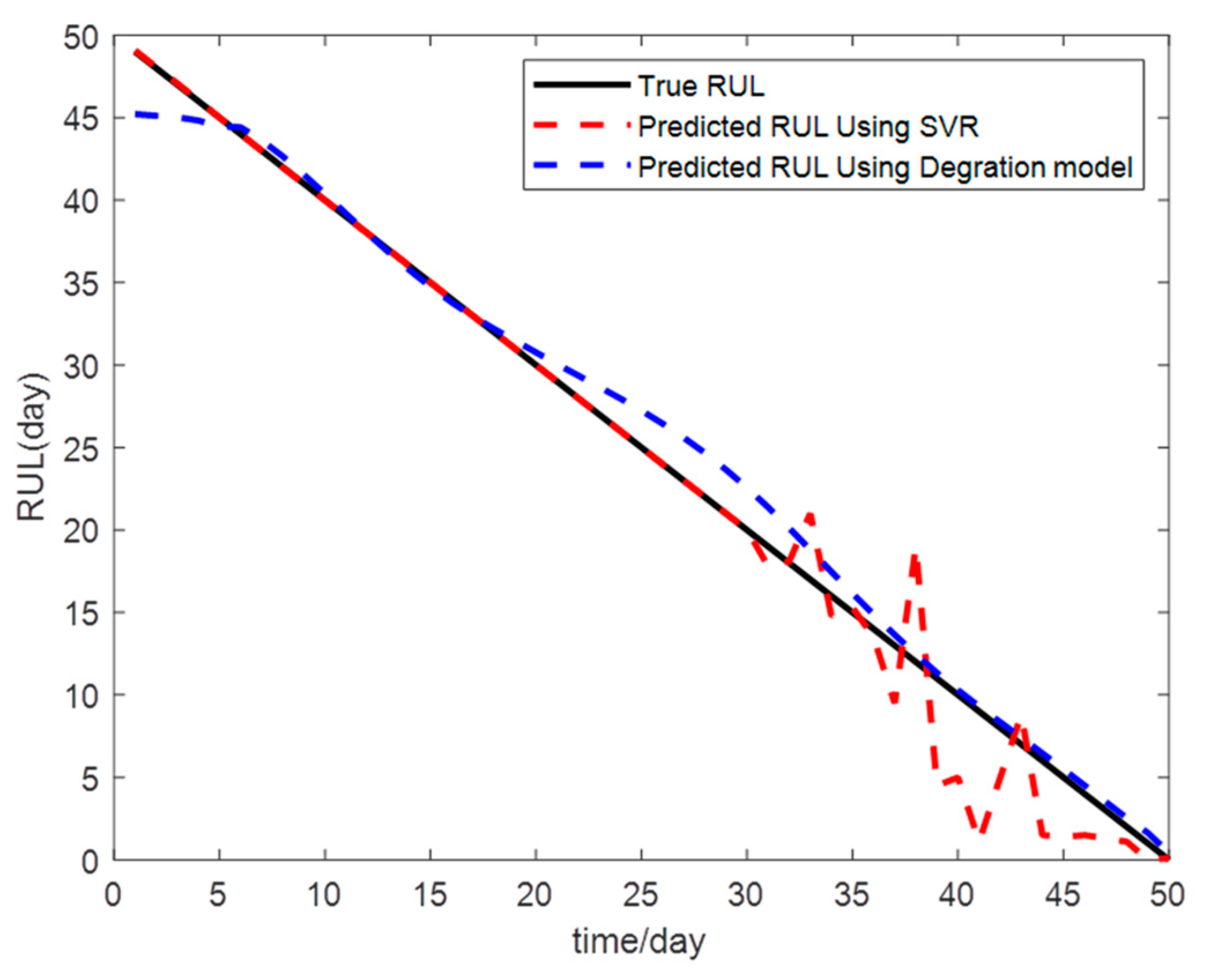
| Expression | Expression | Expression | Expression |
|---|---|---|---|
| Feature Parameters | Expression | Feature Parameters | Expression |
|---|---|---|---|
| Prediction Methods | MAE (%) | RMSE |
|---|---|---|
| SVR | 2.27 | 2.3090 |
| Degration Model | 2.11 | 1.4113 |
Publisher’s Note: MDPI stays neutral with regard to jurisdictional claims in published maps and institutional affiliations. |
© 2021 by the authors. Licensee MDPI, Basel, Switzerland. This article is an open access article distributed under the terms and conditions of the Creative Commons Attribution (CC BY) license (https://creativecommons.org/licenses/by/4.0/).
Share and Cite
Li, Z.; Zhang, X.; Kari, T.; Hu, W. Health Assessment and Remaining Useful Life Prediction of Wind Turbine High-Speed Shaft Bearings. Energies 2021, 14, 4612. https://doi.org/10.3390/en14154612
Li Z, Zhang X, Kari T, Hu W. Health Assessment and Remaining Useful Life Prediction of Wind Turbine High-Speed Shaft Bearings. Energies. 2021; 14(15):4612. https://doi.org/10.3390/en14154612
Chicago/Turabian StyleLi, Zhenen, Xinyan Zhang, Tusongjiang Kari, and Wei Hu. 2021. "Health Assessment and Remaining Useful Life Prediction of Wind Turbine High-Speed Shaft Bearings" Energies 14, no. 15: 4612. https://doi.org/10.3390/en14154612
APA StyleLi, Z., Zhang, X., Kari, T., & Hu, W. (2021). Health Assessment and Remaining Useful Life Prediction of Wind Turbine High-Speed Shaft Bearings. Energies, 14(15), 4612. https://doi.org/10.3390/en14154612





